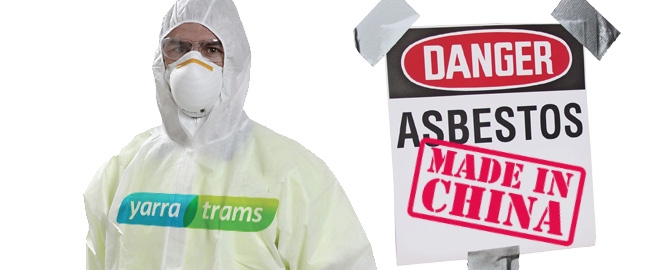Yarra Trams - Cement Sheet Laced with Asbestos Discovered

Imagine you have been working for weeks on a construction site —a brand new building — and one morning your employer produces a letter stating the materials you’ve been cutting with power tools for the last few weeks are not normal cement sheet, but instead, a cement sheet laced with asbestos.
Building materials containing asbestos for a brand new building?
Unions had fought for, and finally won, a ban on the importation of asbestos over a decade ago. How could brand new building materials still be riddled with the cancerous dust of death that cut short the lives of our fathers’ generation?
Yet this is exactly the situation our members recently experienced while installing new substations for the tram network in Melbourne’s suburbs.
How could this happen? Corrupt, substandard overseas suppliers for a start
To understand how this is still happening — not only in Melbourne, but all around Australia — we need to follow these building materials on their journey from their point of origin to Australian construction sites.
In this particular case, the project to deliver these substations was split across two different suppliers. One of these suppliers sourced building materials from China. The other sourced them locally in Australia.
The Chinese-supplied cement sheet product came with a authentication certificate declaring it contained no asbestos; kind of like that Rolex I got online for $15 that also came with an authentication certificate.
To put this in perspective, Transparency International ranks Australia as the 13th least corrupt country in the world. China ranks at equal number 83 alongside Benin and Liberia.
This cement sheet product was installed into more than 50 substations that were shipped to various places around Australia.=
Australian workers exposed to lethal dust throughout the products’ use
Once the substations arrived on sites, electricians and other tradesmen cut holes into them to enable cables to reach the switchgear inside.
These workers used grinders, sabre saws, hole saws and the like: tools that inevitably generated airborne dust that scattered around the substations.
One manager had the nerve to tell an ETU organiser: ‘The air monitoring done showed no airborne asbestos, we don’t believe anyone was exposed.’
To which our Organiser replied, ‘Well of course it showed that, the monitoring had been done days after the work had stopped. Swab tests had shown that asbestos dust was found on top of the cabinets and it certainly didn’t walk up the sides of the cabinets to get there.’
Not just the workers, but also their families are at risk
Did the dust end up on clothes and go home where the Missus did the washing? Did the dust end up in the car that I use to take the kids to footy practice? Is this something I should worry about?
These are the sorts of questions that a Slater & Gordon Asbestos lawyer received when meeting our members who were exposed. But, of course, no one will know the answer to these questions for 20+ years.
The sad reality is: by the time these blokes know for sure that they were exposed, it will be too late. Any asbestos that they may have breathed in is already there. All you can do is hope for the best, and demand to see a certificate of clearance by a hygienist on the next job.
Trading in asbestos for economic gain
With the Chinese Free Trade Agreement being signed by the Liberals and backed by Labor, it begs the question: Why are we trading on equal terms with an undemocratic country racked with corruption and whose environmental protections, workplace rights and human rights are decades behind our own?
As long as Australia continues to import cheap, imported products from third world countries, asbestos exposure will sadly remain a risk for Australians.=
So remember, if you are working on a job, ask the question: where did this cement sheet come from? If it’s not Australian, it should be tested.
It may just save you from a horrible, premature death.